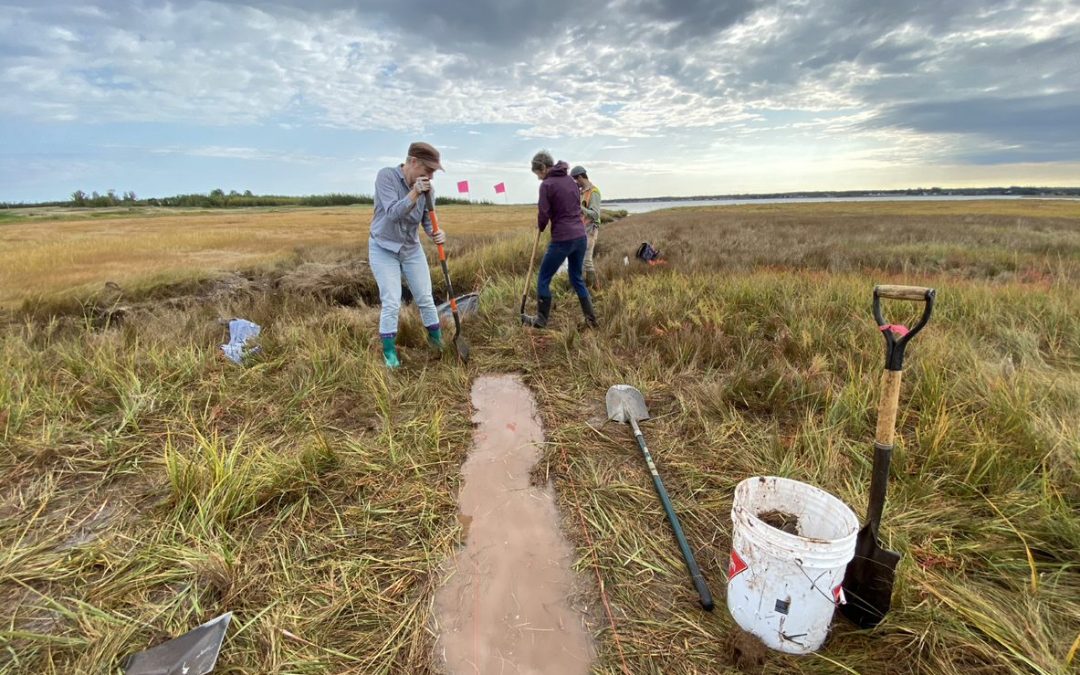On a beautiful fall day in September 2020 a group of people gathered at Brule Shore with their sleeves rolled up and their shovels at the ready. They represented the local community and were the faces of salt marsh experts, dedicated indigenous neighbors, and a handful of devoted volunteers. For many of them, they had just met. Nevertheless, they were gathered together in shared common goal—restoring the salt marsh near Ferguson’s Cove, Nova Scotia.
“The importance of the salt marshes to Nova Scotians can’t be emphasized enough,” said Charlynne Robertson, Manager of Clean Coasts. “They stabilize our coasts, buffer against storms and floods, store carbon, filter water, and are home to many species of plants, fish and wildlife. Salt marshes are culturally important to the Mi’kmaq.”
With most of Nova Scotia surrounded by deep blue coastlines, the Clean Coasts team seeks to improve coastal habitats through natural approaches, restoration, and adaptation methods. As part of the Department of Fisheries and Oceans’ (DFO) Coastal Restoration Fund (CRF), they worked collaboratively with diverse groups of individuals, organizations, and governments to identify, assess, monitor, and restore a salt marsh in Brule Shore, Nova Scotia.
Coastal restoration – the cause, the solution, and the involvement
Coastal restoration practitioners with Restore America’s Estuaries (RAE) and CB Wetland and Environmental Specialists (CBWES) helped the team identify the site and highlight signs of degradation at the marsh. They prepared monitoring equipment to detect environmental changes and advised the team on the restoration design, monitoring and adaptive management that continues to be carried out at the site today. Due to agricultural modifications decades ago, built-up ditches and an earthen dyke trapped surface water and restricted tidal flow from moving in and out of the marsh. For this reason, a section of the marsh was waterlogged and ultimately drowning, destroying critical coastal habitat.
The plan to restore 0.7 hectare of salt marsh habitat involved digging small channels of water, also known as runnels, to assist the drainage of a large, shallow and waterlogged pool that had been trapped. These runnels would help promote proper tidal movement, restoring plant and fish habitat.
The success of this project would not only be measured by the restoration of the salt marsh, but also, by the receptiveness and involvement of the community to support it. Before any shoveling could take place, Clean Coasts made sure to mail letters to the community, get approval from the sole landowner of the salt marsh property and sought consent from the Chief and Council of Millbrook First Nation for the restoration project as that area was culturally significant to the Millbrook community. They worked with Boreas Heritage Consulting Inc. to ensure that the site did not contain any culturally significant resources to the Mi’kmaq. The Confederacy of Mainland Mi’kmaq helped Clean Coasts coordinate a citizen science event where local community members helped obtain baseline data of species around the area, recording over 229 species. The team used this restoration work as an opportunity to offer coastal restoration related training to the six local stewards chosen to restore Brule Shore. These eager participants had the opportunity to build skills and knowledge in salt marsh ecology and restoration, learn more about the Mi’kmaw history in the area and the cultural significance of salt marsh ecosystems, and train under experts in the field of coastal restoration. Every participant showed a strong interest in restoring Brule Shore, and an eagerness to share the teachings with the wider community.
“What a great experience to work with Clean last Saturday,” said Nicole Uzans. “This was my first introduction to your work and I was so, so impressed. Each of you is passionate, knowledgeable, and ready to share what’s important about this project – and spending some in-person time with you was a real gift, especially in these distanced times. Now that I’m so inspired, I’m also excited to share what I experienced with others who live in this area. Thank you for looking at this part of Nova Scotia with two-eyed vision and hearts full of care. I look forward to staying involved with y’all.”
In the end, collaboration is everything
Community involvement is crucial to coastal resilience. If it were not for the efforts and work of partners, collaborators, and volunteers of the salt marsh restoration project, Clean Coasts would not have been able to restore Brule Shore. This process not only taught the team about methodology, coastal stewardship, and adaptive management but also built meaningful relationships which they will continue to maintain and grow through future projects and collaborations.

Recent Comments